Artist Christo who wrapped Reichstag in fabric dies aged 84
The artist known as Christo, who made his name transforming landmarks such as Germany's Reichstag by covering them with reams of cloth, died on Sunday aged 84, his official Facebook page announced.

Christo Vladimirov Javacheff died of natural causes at his home in New York City, the statement said.
The Bulgarian-born artist worked in collaboration with his wife of 51 years Jeanne-Claude until her death in 2009.
Their large-scale productions would take years of preparation and were costly to erect; but they were mostly ephemeral, coming down after just weeks or months.
"Christo lived his life to the fullest, not only dreaming up what seemed impossible but realising it," said a statement from his office.
"Christo and Jeanne-Claude's artwork brought people together in shared experiences across the globe, and their work lives on in our hearts and memories."
In accordance with Christo's wishes, the statement added, a work in progress, "l'Arc de Triomphe, Wrapped", would be completed. The event is on schedule to be shown from September 18 in 2021.
Born on June 13, 1935 in Gabrovo, Bulgaria, Christo left his home country in 1957, living in several countries before arriving in Paris, where he met his future wife.
Next year's work in Paris will be accompanied by an exhibition at the city's Pompidou Centre about their time in the city. That show is due to start in July this year, running through until the end of October 2021.
As well as the German Reichstag, another of their major projects was wrapping the Pont Neuf, Paris's oldest bridge, in 1985.
Sunday's statement from Christo's office concluded: "In a 1958 letter Christo wrote, 'Beauty, science and art will always triumph'. We hold those words closely today."
'Wrapped Reichstag' artist Christo dies, aged 84
He was most famous for wrapping huge buildings and spaces, such as the Reichstag in Berlin and Paris' Pont-Neuf. American-Bulgarian artist Christo has died at the age of 84.
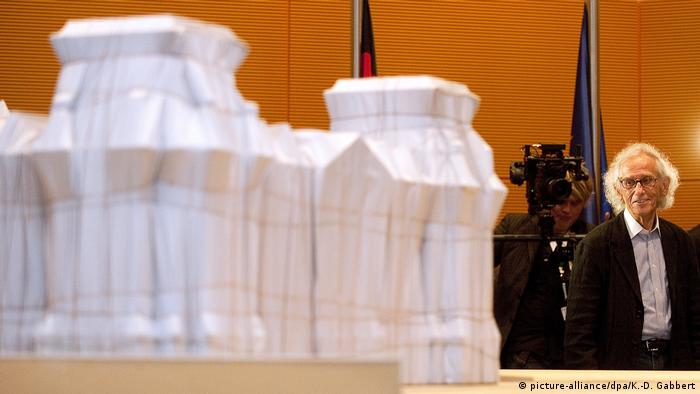
His last monumental work was to be the Arc de Triomphe in Paris. In the fall of 2020, Christo was to cover the famous landmark with 25,000 square meters (270,000 square feet) of silver blue recyclable polypropylene fabric, tied with 7,000 meters of red rope.
Christo however didn't get to witness the unveiling of his ambitious installation. On May 31, the world famous Bulgarian-American artist died of natural causes at his home in New York City.
"Christo lived his life to the fullest, not only dreaming up what seemed impossible but realising it," said a statement from his office.
Wrapping to awake curiosity
Shiny fabrics that covered buildings, objects or entire areas were his trademark. Together with his wife Jeanne-Claude, who died in 2009, he wrapped the Reichstag in Berlin, trees in Switzerland or paths in Kansas City. And sometimes he just covered up air in big "air packages."
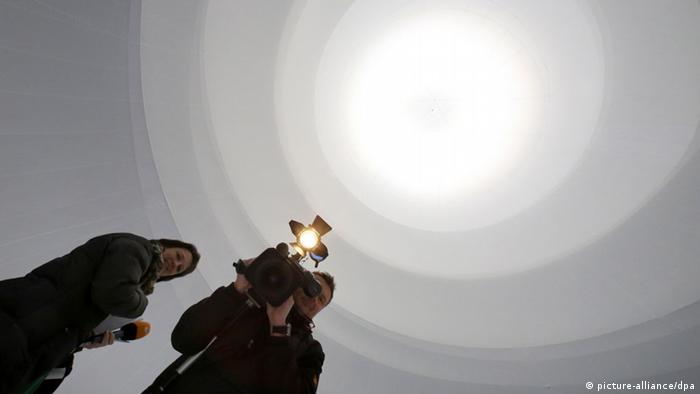
Christo's big 'air packages'
Christo and Jeanne Claude planned together large-scale projects such as the oversized Valley Curtain installed between two Colorado mountain slopes in the early 1970s.
Other spectacular works include the pink Surrounded Islands in Florida and the Pont-Neuf Wrapped bridge installation in Paris in the 1980s. In 1995, the artist couple wrapped the German Reichstag in silver glittering fabric.
In 2016, some 1.3 million visitors walked on his Floating Piers across Lake Iseo. "I love real things, real wind, real dryness, real wet, real fear and real joy," Christo told a group of Italian students in the documentary Walking on Water.
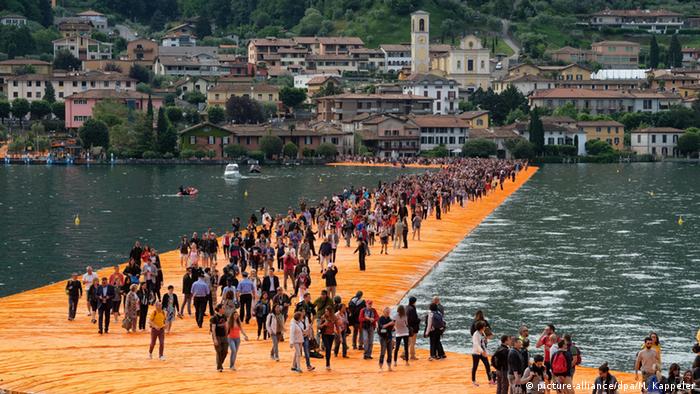
Christo's Floating Piers across Lake Iseo
Christo started wrapping or covering items such as cans, bottles and boxes early on in his artistic career. Yet he always rejected being defined as a "packaging artist."
He left the interpretation of his art to others, but his basic approach was to arouse the curiosity of viewers by concealing objects, without ever changing them beyond recognition — a process the artist's biographer, David Bourdon, described as "revealing by hiding."
Famous artist couple: Christo & Jeanne-Claude
Christo Vladimiroff Javacheff was born in Bulgaria on June 13, 1935. In the 1950s he studied painting, sculpture and architecture in Sofia. In 1956, he fled the communist country across the Czechoslovak border.
In Paris at the beginning of the 1960s, he joined a group of artists known as the "Nouveaux Réalistes" — the new realists — who, among other things, integrated real-life objects into art by transforming them.
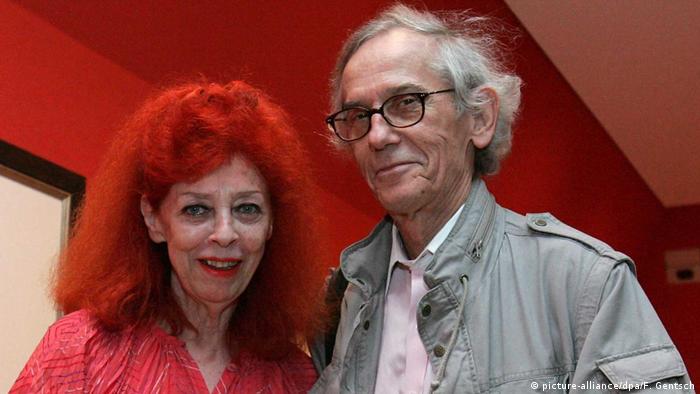
Christo and Jeanne-Claude in 2006
To earn money, Christo also painted portraits. While working for a general, he met his daughter, Jeanne-Claude, who was born on the same day as he was. Jeanne-Claude was first seduced by Christo's charm; her enthusiasm for his art came later. She contributed to his artistic talent through her organizational skills.
Relations with Germany
Wolfgang Volz became the couple's official photographer in 1972. "Although Christo had a worldwide reputation, I never worked 'for' the two of them, but 'with' them as equal partners," Volz once told DW. That's why their relationship lasted so long, even though Christo could also be difficult, having a reputation for being short-tempered and stubborn when it came to realizing the detailed concepts of his works exactly according to his plans.
Over time, his art projects became increasingly ambitious. "The 'working family' grew with the size of the projects," said Volz on the occasion of Christo's 80th birthday. "Engineers, professional climbers and other specialists were needed."
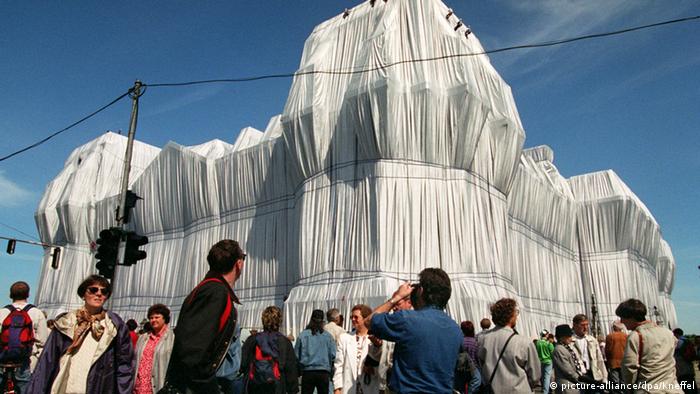
The veiling of the Reichstag in 1995 was one of Christo's most ambitious projects
Christo's panels of fabrics were made in Germany, where he also realized one of his most ambitious projects, the veiling of the Berlin Reichstag in 1995.
Within two weeks, five million visitors had admired the impressive sparkling Wrapped Reichstag. Christo had been waiting for over 20 years to realize this project.
Freedom as a driving artistic force
As a representative of so-called Environmental or Land Art, Christo, together with Jeanne-Claude, undertook many spectacular wrapping and design campaigns for buildings, parks and entire areas.
In the 1960s, a time of social upheaval, Land Art had a political dimension. Geographical spaces were transformed into works of art that could not be owned — a form of protest against property and the bourgeoisie.

One of the artists' most spectacular installations, 'Umbrellas,' from the early 70s
Christo remained true to this ideal until the end. His large-scale installations were only visible for a short period, but they were open to the public and free of charge for everyone. "The fact that they disappear is part of the aesthetic concept. They are deeply rooted in freedom, because freedom is an enemy of property — while property is linked to durability," said Christo as he worked on the Wrapped Reichstag in Berlin.
Freedom has always been a central concept for the former refugee from Bulgaria. In order to remain independent, he financed his projects from the sale of sketches and merchandise related to his works.
An artist with a political stance
Christo's socio-critical ambitions became artistic happenings that fascinated the public. Jeanne-Claude often described their work this way: "We create temporary works of art of joy and beauty."
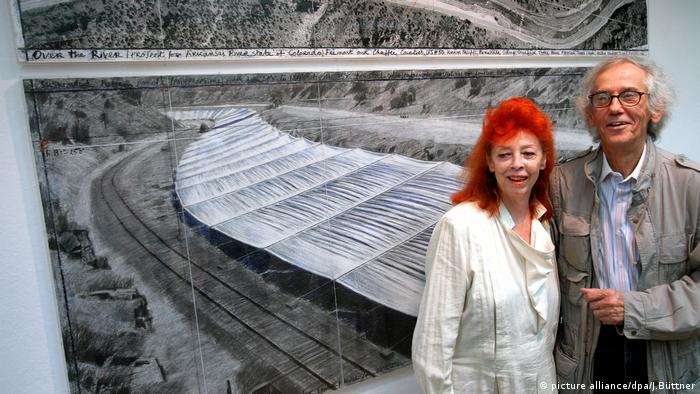
Christo and Jeanne-Claude working on their project 'Over the River'
But all while promoting beauty and joy, Christo remained political. He gave up his Over the River project in Colorado, which he had been developing for 20 years, in protest against US President Donald Trump in 2017. "The US government is our landlord here," Christo told The New York Times. "It owns the country. I cannot do a project that benefits this landlord."
Oil barrels for a grave
Christo not only covered buildings and landscapes; oil barrels were another recurring material in his art. In 1962, he blocked the Rue Visconti in Paris with a wall made of 441 oil barrels. He called the work The Iron Curtain, created in protest against the East German regime and the construction of the Berlin Wall.
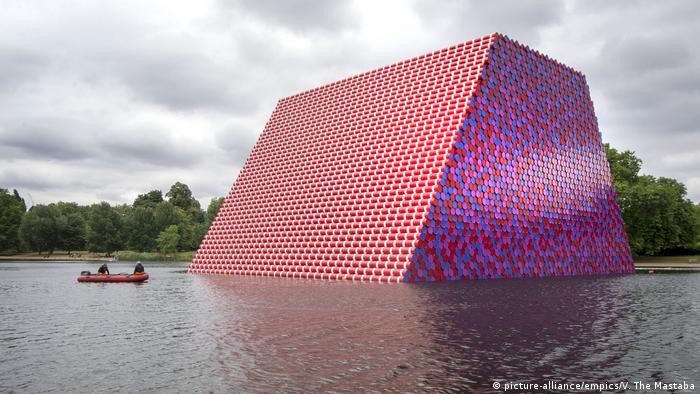
The Mastaba in Hyde Park
In 1977, Christo and Jeanne-Claude designed The Mastaba, inspired by Ancient Egyptian tombs. They aimed to build a colorful pyramid without a tip made of 410,000 oil barrels in the United Arab Emirates desert near Abu Dhabi.
Christo realized smaller versions of this pyramid, most recently a floating Mastaba of 7,506 oil barrels in London's Hyde Park in 2018. The Abu Dhabi Mastaba in the desert, which would have been the world's largest sculpture and his only large-scale permanent installation, remained one of his longstanding unfulfilled dreams.
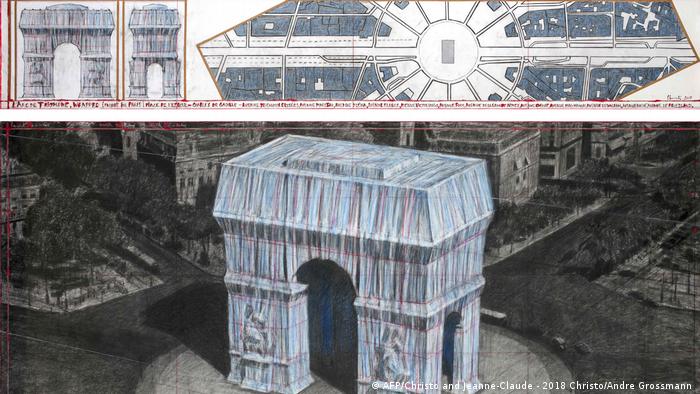
CHRISTO AND HIS LARGE-SCALE ARTWORKS
Wrapping the Arc de Triomphe (2020)
The "Arc de Triomphe, Wrapped" was announced as the last large-scale project completed by Christo during his lifetime. The Parisian landmark at the end of the Champs Elysees was to be covered in September 2020 with a silvery-blue recyclable fabric, tied by a red rope. Christo and his wife Jeanne-Claude had developed the concept for this installation back in 1962.
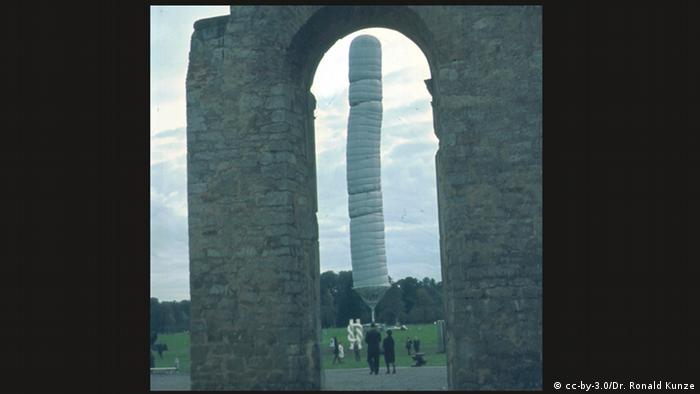
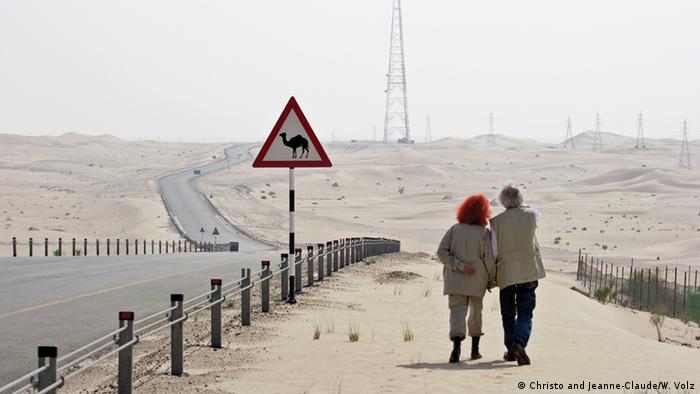
SEE MORE PHOTOS HERE
12345678910111213
Date 31.05.2020
Author Gaby Reucher
Related Subjects Christo, Reichstag, Norman Foster
Keywords Christo, artist, Reichstag, New York City
Permalink https://p.dw.com/p/3d5WI
The Bulgarian-born artist worked in collaboration with his wife of 51 years Jeanne-Claude until her death in 2009.
Their large-scale productions would take years of preparation and were costly to erect; but they were mostly ephemeral, coming down after just weeks or months.
"Christo lived his life to the fullest, not only dreaming up what seemed impossible but realising it," said a statement from his office.
"Christo and Jeanne-Claude's artwork brought people together in shared experiences across the globe, and their work lives on in our hearts and memories."
In accordance with Christo's wishes, the statement added, a work in progress, "l'Arc de Triomphe, Wrapped", would be completed. The event is on schedule to be shown from September 18 in 2021.
Born on June 13, 1935 in Gabrovo, Bulgaria, Christo left his home country in 1957, living in several countries before arriving in Paris, where he met his future wife.
Next year's work in Paris will be accompanied by an exhibition at the city's Pompidou Centre about their time in the city. That show is due to start in July this year, running through until the end of October 2021.
As well as the German Reichstag, another of their major projects was wrapping the Pont Neuf, Paris's oldest bridge, in 1985.
Sunday's statement from Christo's office concluded: "In a 1958 letter Christo wrote, 'Beauty, science and art will always triumph'. We hold those words closely today."
'Wrapped Reichstag' artist Christo dies, aged 84
He was most famous for wrapping huge buildings and spaces, such as the Reichstag in Berlin and Paris' Pont-Neuf. American-Bulgarian artist Christo has died at the age of 84.

His last monumental work was to be the Arc de Triomphe in Paris. In the fall of 2020, Christo was to cover the famous landmark with 25,000 square meters (270,000 square feet) of silver blue recyclable polypropylene fabric, tied with 7,000 meters of red rope.
Christo however didn't get to witness the unveiling of his ambitious installation. On May 31, the world famous Bulgarian-American artist died of natural causes at his home in New York City.
"Christo lived his life to the fullest, not only dreaming up what seemed impossible but realising it," said a statement from his office.
Wrapping to awake curiosity
Shiny fabrics that covered buildings, objects or entire areas were his trademark. Together with his wife Jeanne-Claude, who died in 2009, he wrapped the Reichstag in Berlin, trees in Switzerland or paths in Kansas City. And sometimes he just covered up air in big "air packages."

Christo's big 'air packages'
Christo and Jeanne Claude planned together large-scale projects such as the oversized Valley Curtain installed between two Colorado mountain slopes in the early 1970s.
Other spectacular works include the pink Surrounded Islands in Florida and the Pont-Neuf Wrapped bridge installation in Paris in the 1980s. In 1995, the artist couple wrapped the German Reichstag in silver glittering fabric.
In 2016, some 1.3 million visitors walked on his Floating Piers across Lake Iseo. "I love real things, real wind, real dryness, real wet, real fear and real joy," Christo told a group of Italian students in the documentary Walking on Water.

Christo's Floating Piers across Lake Iseo
Christo started wrapping or covering items such as cans, bottles and boxes early on in his artistic career. Yet he always rejected being defined as a "packaging artist."
He left the interpretation of his art to others, but his basic approach was to arouse the curiosity of viewers by concealing objects, without ever changing them beyond recognition — a process the artist's biographer, David Bourdon, described as "revealing by hiding."
Famous artist couple: Christo & Jeanne-Claude
Christo Vladimiroff Javacheff was born in Bulgaria on June 13, 1935. In the 1950s he studied painting, sculpture and architecture in Sofia. In 1956, he fled the communist country across the Czechoslovak border.
In Paris at the beginning of the 1960s, he joined a group of artists known as the "Nouveaux Réalistes" — the new realists — who, among other things, integrated real-life objects into art by transforming them.

Christo and Jeanne-Claude in 2006
To earn money, Christo also painted portraits. While working for a general, he met his daughter, Jeanne-Claude, who was born on the same day as he was. Jeanne-Claude was first seduced by Christo's charm; her enthusiasm for his art came later. She contributed to his artistic talent through her organizational skills.
Relations with Germany
Wolfgang Volz became the couple's official photographer in 1972. "Although Christo had a worldwide reputation, I never worked 'for' the two of them, but 'with' them as equal partners," Volz once told DW. That's why their relationship lasted so long, even though Christo could also be difficult, having a reputation for being short-tempered and stubborn when it came to realizing the detailed concepts of his works exactly according to his plans.
Over time, his art projects became increasingly ambitious. "The 'working family' grew with the size of the projects," said Volz on the occasion of Christo's 80th birthday. "Engineers, professional climbers and other specialists were needed."

The veiling of the Reichstag in 1995 was one of Christo's most ambitious projects
Christo's panels of fabrics were made in Germany, where he also realized one of his most ambitious projects, the veiling of the Berlin Reichstag in 1995.
Within two weeks, five million visitors had admired the impressive sparkling Wrapped Reichstag. Christo had been waiting for over 20 years to realize this project.
Freedom as a driving artistic force
As a representative of so-called Environmental or Land Art, Christo, together with Jeanne-Claude, undertook many spectacular wrapping and design campaigns for buildings, parks and entire areas.
In the 1960s, a time of social upheaval, Land Art had a political dimension. Geographical spaces were transformed into works of art that could not be owned — a form of protest against property and the bourgeoisie.

One of the artists' most spectacular installations, 'Umbrellas,' from the early 70s
Christo remained true to this ideal until the end. His large-scale installations were only visible for a short period, but they were open to the public and free of charge for everyone. "The fact that they disappear is part of the aesthetic concept. They are deeply rooted in freedom, because freedom is an enemy of property — while property is linked to durability," said Christo as he worked on the Wrapped Reichstag in Berlin.
Freedom has always been a central concept for the former refugee from Bulgaria. In order to remain independent, he financed his projects from the sale of sketches and merchandise related to his works.
An artist with a political stance
Christo's socio-critical ambitions became artistic happenings that fascinated the public. Jeanne-Claude often described their work this way: "We create temporary works of art of joy and beauty."

Christo and Jeanne-Claude working on their project 'Over the River'
But all while promoting beauty and joy, Christo remained political. He gave up his Over the River project in Colorado, which he had been developing for 20 years, in protest against US President Donald Trump in 2017. "The US government is our landlord here," Christo told The New York Times. "It owns the country. I cannot do a project that benefits this landlord."
Oil barrels for a grave
Christo not only covered buildings and landscapes; oil barrels were another recurring material in his art. In 1962, he blocked the Rue Visconti in Paris with a wall made of 441 oil barrels. He called the work The Iron Curtain, created in protest against the East German regime and the construction of the Berlin Wall.

The Mastaba in Hyde Park
In 1977, Christo and Jeanne-Claude designed The Mastaba, inspired by Ancient Egyptian tombs. They aimed to build a colorful pyramid without a tip made of 410,000 oil barrels in the United Arab Emirates desert near Abu Dhabi.
Christo realized smaller versions of this pyramid, most recently a floating Mastaba of 7,506 oil barrels in London's Hyde Park in 2018. The Abu Dhabi Mastaba in the desert, which would have been the world's largest sculpture and his only large-scale permanent installation, remained one of his longstanding unfulfilled dreams.

CHRISTO AND HIS LARGE-SCALE ARTWORKS
Wrapping the Arc de Triomphe (2020)
The "Arc de Triomphe, Wrapped" was announced as the last large-scale project completed by Christo during his lifetime. The Parisian landmark at the end of the Champs Elysees was to be covered in September 2020 with a silvery-blue recyclable fabric, tied by a red rope. Christo and his wife Jeanne-Claude had developed the concept for this installation back in 1962.

Packaging air (1968)
Christo developed his first elaborate installations in the 1960s, wrapping everyday objects such as chairs, magazines and oil drums. Later he created "Air Packages" such as this 5,600-cubic-meter installation at the Documenta 4 art fair in Kassel in 1968, which earned him worldwide recognition.

CHRISTO AND HIS LARGE-SCALE ARTWORKS
A monument to the artist couple
The Mastaba in London was a foretaste of the great mastaba that Christo and Jeanne-Claude had planned for Abu Dhabi. The gigantic pyramid of 410,000 oil barrels was to be the artist couple's first major permanent project. They often visited their desired location in the desert of the United Arab Emirates. "The Mastaba," featured on Christo's homepage, remained a dream.
Author: Gaby Reucher
12345678910111213
Date 31.05.2020
Author Gaby Reucher
Related Subjects Christo, Reichstag, Norman Foster
Keywords Christo, artist, Reichstag, New York City
Permalink https://p.dw.com/p/3d5WI
No comments:
Post a Comment